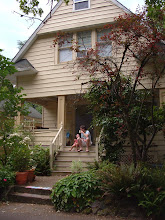Alex completely busted me having yet another sentimental moment the other day. It was when we were prying the lath off the studs in the kitchen. I commented that what we were doing was sort of sad because someone more than a hundred years ago had put this house together, nail by nail, strip by strip, and here we were, tearing it all apart in mere hours.
Over lunch today, he said my remark surprised him because, of the two of us, I've always been less concerned about preserving the traditional characteristics of our houses. While Alex digs through piles of old molding in the bowels of Hippo Hardware, I peruse Dwell magazine to figure out how to make our traditional house more modern. In both of the older homes that we've owned and remodeled, I've rallied to open up our floor plans and use modern materials and designs in our updates. But it doesn't mean I don't recognize the symbols of the past as important, too.
As part of my job, I attended a meeting on Wednesday, with about fifty of the state's heritage, history, and preservation folks, to brainstorm ideas for a conference next year. At one point, one gentleman raised the issue of how sustainability, for which Portland is famous, and preservation could work together. He commented that sustainability efforts in urban planning tended to involve tearing down older, historic homes and putting up higher-density new dwellings. It was an interesting observation: how do we move forward to address the way we live now (Drywall and bamboo floors) but also protect and preserve the creations of our past (lathe and hardwoods)?
Is this a line that anyone can really walk? Though many folks I know work hard to preserve or restore the original details of their homes, no one is putting up whole walls of lath instead of sheetrock. Companies like Rejuvenation Hardware and Pottery Barn seem to do this, creating and selling products that nod to the past. And New Urbanist architects and planners develop mixed-use commercial/residential neighborhoods and traditional-looking houses with porches in an effort to recreate an idealized lifestyle--one that my planner husband is quick to point out is no longer a reality. Cities are too big, many Americans can't afford to live close to where they work, communities are built less around neighborhoods and more around common lifestyles and shared interests. So perhaps these gestures to the past are at best nostalgic and at worst marketing.
As we pull our house apart at the seams and find treasures of the past hidden in its walls, I am reminded again of the basic purpose of a house: to shelter a family, no matter when or how they live there. That's continuity--it links our past and our future no matter the materials and politics involved.
Thursday, August 7, 2008
Subscribe to:
Post Comments (Atom)




No comments:
Post a Comment